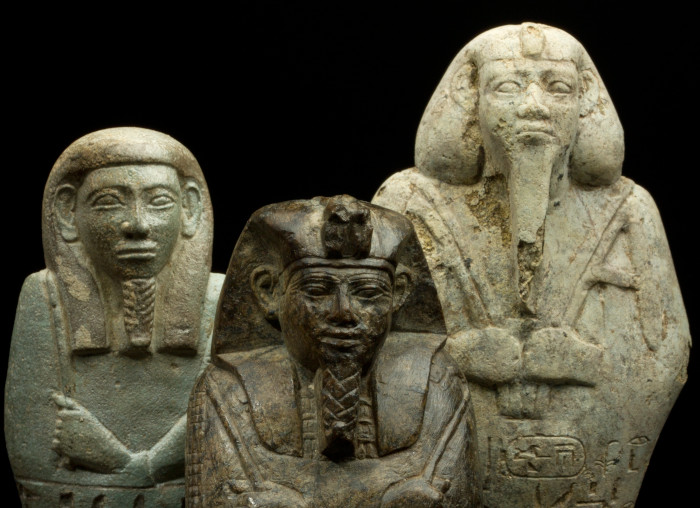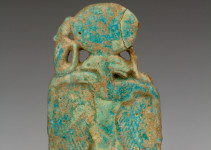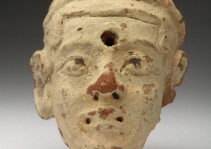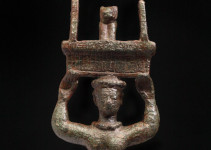Exhibitions
Departments
Egypt in Nubia, the Nubians in Egypt
In the second half of the 2nd millennium BC Lower Nubia again came under Egyptian rule. The province was ruled by an official seated in Aniba, with the title “Royal son of the Kingdom of Kush”. Annual tribute of “Nubian gold” and other precious items was often depicted on paintings decorating graves of the dignitaries in Thebes. Large military expeditions carried out by pharaohs of Dynasties XVIII and XIX reached even the area of the Third Cataract of the Nile, where the town of Soleb was founded. Ramzes II (1279-1213 BC) built seven large temples in Nubia, including the two best known – in Abu Simbel. At the same time, Nubian soldiers were still being incorporated into the Egyptian army. The horizon of the so-called Pan-Grave culture from Upper Egypt indicates that a large population of newcomers from the south settled there.
In the shadow of the holy rock
At the foot of the holy mountain, called Gebel Barkal by the Arabs, Pharaoh Thutmosis III, ca. 1460 BC, founded the city of Napata. The place, located at the peripheries of the Kingdom of Kerma, was the southernmost town permanently inhabited by Egyptians. During the reign of Tutankhamun, a huge temple devoted to the god Amun was built to be later expanded. This temple was one of the most important cult centres in the times of the New Kingdom. When towards the end of the 20th Dynasty, Egypt lost control of Nubia, the town came under the rule of a local Kushite dynasty. Initially, the dynasty's power was limited to the immediate surroundings of Napata. In the 9th century the rulers of Napata started their expansion, and soon this small kingdom developed into a powerful monarchy, with frontiers reaching Elephantine under the rule of Kashta (8th century BC), who styled himself the Lord of Lower and Upper Egypt.
The black pharaohs
The tombs of the Kings of Kush initially had the form of stone circles, but they soon gave way to small, slender step pyramids. Probably the first rulers known by name, the creators of the true power of the Kush, were Alara and his successor Kashta (8th century). The son of the latter, Pije (Pianchi, ca. 747-716 B.C.), under the pretext of protecting Upper Egypt from the temptations of rulers of Sais in the Delta, conquered these lands, declaring himself Pharaoh, the ruler of all lands. And here, unexpectedly, the Nubians, who had been seen as slaves by the Egyptians and shown as captives on the soles of sandals, became pharaohs and the ruling class of Egypt, establishing in 716 BC the 25th Dynasty. The real creator of the Dynasty, however, was probably Pianchi's brother, Shabaka, who managed to crush the Egyptian rebellion and maintain constant control over the state. Only the Nile Delta remained under the authority of the indigenous Egyptian provincial dynasties, which, however, generally recognised the authority of Kush.
The new pharaohs, although they retain their exotic costume and a number of their customs, are at the same time fascinated by the tradition and culture of Egypt, which owes them a period of the unprecedented revival of art, architecture and writing that took place at that time, with a reference to archaic traditions that date back to the Old and Middle Kingdom. The kings of the 25th dynasty accepted the official title of the memorial pharaohs, initiated the construction of the pyramids and renovated the old temples. In Thebes the actual power was exercised by the high priests - divine adorers of Ammun, who were exclusively women from the ruling dynasty, usually sisters or daughters of the king.
The peak of power was reached by the rulers of the 25th dynasty during the reign of Taharka (690-664 BC). However, in the year 669 BC this Kushite pharaoh was driven out of Egypt by Assyrians, where he soon died. He was buried with the splendour at the new cemetery in Nuri, in his pyramid - the largest that ever stood in Nubia (about 60 m high). The attempts by the next ruler, Tanutamani, to regain control of Egypt were unsuccessful. In the next centuries, the Kushite kingdom in Central Sudan continues, although in isolation from the Mediterranean world and the North. Greeks, who as mercenaries and merchants started to come to Egypt in increasing numbers in the next centuries, called the Nubians "Ethiopians" (Aethiopae) and created their legend as flawless people, founders of the Egyptian state. However, Egypt, reunited again, was growing in power and in 593 BC the army of Pharaoh Psametik II invaded Nubia. The army of Napata was defeated, and the victors probably conquered and looted the capital city, destroying its temples and statues.
Nasza strona internetowa używa plików cookies (tzw. ciasteczka) w celach statystycznych, reklamowych oraz funkcjonalnych. Dzięki nim możemy indywidualnie dostosować stronę do twoich potrzeb. Każdy może zaakceptować pliki cookies albo ma możliwość wyłączenia ich w przeglądarce, dzięki czemu nie będą zbierane żadne informacje. Dowiedz się więcej jak je wyłączyć. OK, Rozumiem






